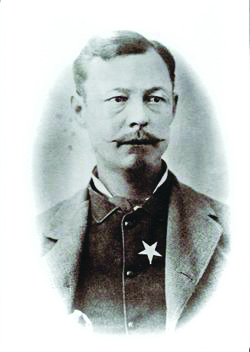By Steve Chapman
Baxter Stingley was one of the first people to arrive in Salida, in 1880. He was part of the exodus from nearby Cleora, when that boom town went bust overnight, following the relocation of the railroad.
Stingley and his brother Jessie arrived in the Arkansas Valley from Iowa. Not much is written of his life prior, but Baxter Stingley was 36 when he settled in Salida.
An entrepreneur, he quickly formed Stingley and Company, a saloon. That enterprise ended almost as soon as it started, and his partner bought him out. Stingley went down the road to Poncha Springs, another boom town, and attempted to run a new saloon.
By October, 1881, he was working as a deputy marshal back in Salida.
 Unlike on television and movies, the life of a wild West peace keeper wasn’t glamorous or constantly filled with gun battles. Stingley’s main jobs included removing stray dogs, supervising crews in the cleanup of trash from the streets and collecting poll taxes from voters. Townsfolk were grateful to have such a man in their midst. Stingley not only wanted to keep them safe, he wanted to keep the town attractive and civilized. For his hard work, Stingley received $75 a month, equivalent to about $1,800 in today’s dollar.
Unlike on television and movies, the life of a wild West peace keeper wasn’t glamorous or constantly filled with gun battles. Stingley’s main jobs included removing stray dogs, supervising crews in the cleanup of trash from the streets and collecting poll taxes from voters. Townsfolk were grateful to have such a man in their midst. Stingley not only wanted to keep them safe, he wanted to keep the town attractive and civilized. For his hard work, Stingley received $75 a month, equivalent to about $1,800 in today’s dollar.
By all accounts, Stingley was an even-tempered, reasonable person. If a man couldn’t afford his fine for an offense, Stingley put him to work, typically on one of many beautification projects. Baxter Stingley’s crews are credited with planting trees in Alpine Park and Riverside Park, as well as throughout Salida. The area had little natural vegetation.
Stingley had his eye on political office from the beginning, and ran for the position of delegate to the state convention in 1882. He also put his name in the hat for constable, running against James Bathurst (among others), a man who would become Baxter’s Deputy.
In addition to admirable qualities as a man and a leader, Stingley was known for his bravery. Only once is he recorded to have backed down from a confrontation, and then only because he faced multiple guns pointed at him from multiple directions. Otherwise, Stingley dealt with trouble head-on.
As written in the November issue of Colorado Central Magazine, on May 30, 1883, Marshal Stingley was shot in the groin and chest during the wildest shootout in Salida history, but he survived after weeks of hovering near death from a punctured lung.
[InContentAdTwo]
Nearly five months to the day after the Labor Day gunfight, Marshal Baxter Stingley again found himself facing bullets.
Healed from his Labor Day wounds and back on the job, Stingley was making his rounds, as usual on the evening of October 28, 1883.
On the far west end of First Street was Ayer Dance and Variety Hall. Stories vary as to what led to Stingley’s arrival at the saloon. One reporter wrote that Stingley was aware two fugitives, Frank Reed and Ernest Christinson, were drinking there. Each man had outstanding warrants. Others wrote that Stingley showed up at the saloon unaware Reed and his friend were there, and that things simply unfolded.
Regardless of the impetus, Stingley walked into Ayer’s and noted a local reporter in the bar. The bartender nodded towards the bar, where Stingley saw Frank Reed leaning against the counter with his hands in his coat pockets.
Several months earlier, Reed’s other partner was lynched in Salida for cattle rustling. After his friend’s death, Reed stated publicly that no Marshall would ever take him alive.
Without hesitation, Stingley pulled one of two guns he carried and approached Reed, but he made a tactical error. Rather than heading straight toward Reed and leaving space between the two, Stingley came at the man from the side, sticking a gun in Reed’s side. Stating he had a warrant, Stingley demanded the outlaw remove his hands from his pockets. Reed complied.
Along with his hands, Reed pulled a gun from his coat pocket and fired, repeatedly. Marshall Baxter Stingley was shot in his side, his left arm, and his right thigh. Staggering backward, Stingley fired shots of his own, but Reed escaped.
Stories chronicled Reed’s future movements and arrests around the country, but he was never returned for a trial. The “why” is clouded.
After the brief gunfight, Stingley collapsed and was placed on a table by patrons. Removing the man’s boots, they noticed one was filled with blood. Reed’s shot hit an artery, and shortly after echoes from the rounds ceased, so did the life of Baxter Stingley. The town was devastated.
A good man, a good law enforcement officer, was dead. All Salida businesses closed for Stingley’s funeral, which was held at the Craig Opera House. After the services, a procession over a mile long gathered to accompany Stingley’s body to Cleora, where he was buried in the northeast corner.
Steve Chapman, owner of Salida Walking Tours, is a self-professed history nerd who spends his non-research hours with Rez, a Red Heeler puppy, and Gina, a 13-year-old Jeep Wrangler.


